The increase in popularity and availability of high-pivot bikes isn’t a coincidence, with success at Downhill World Cup events highlighting the benefits of a rearward wheel axle path – such as improved grip and better bump absorption on rough terrain – for all to see.
Alongside big-rig downhill bikes, brands have been developing trail bikes, enduro bikes and freeride high-pivot bikes that make sense for the everyday rider, but questions still linger about their suitability outside of the downhill setting.
To find out whether high-pivot bikes live up to the hype, I pitted two very different bikes – the Norco Shore 2 high-pivot bike and Orange Alpine Evo LE low-pivot bike – against one another.
These two test bikes might seem a bit ‘Jekyll and Hyde’ at first glance – but they encapsulate the archetypal design and qualities of each suspension type.
In this test, I’ve concentrated on how the two different suspension systems ride against one another.
However, you can also read my individual reviews of the Norco Shore 2 and Orange Alpine Evo LE to see how they fare on their own. And before we get started, you can also read BikeRadar's full explainer on high-pivot bikes.
Introducing the bikes
Right then, let me introduce the two bikes.
On one hand, the Orange Alpine Evo, a reworked version of one of the brand’s most popular models, dating back more than 10 years, has a traditional single low pivot with 155mm of suspension travel.
Although it’s not a thoroughbred enduro race bike, the Orange EWS team have raced it at certain events in the 2021 calendar, and its geometry figures wouldn’t look out of place on a bike with significantly more travel.
This mash-up makes the Orange a worthy one-bike quiver, and certainly up to the challenge of taking on the high-pivot big-hitter in this test.
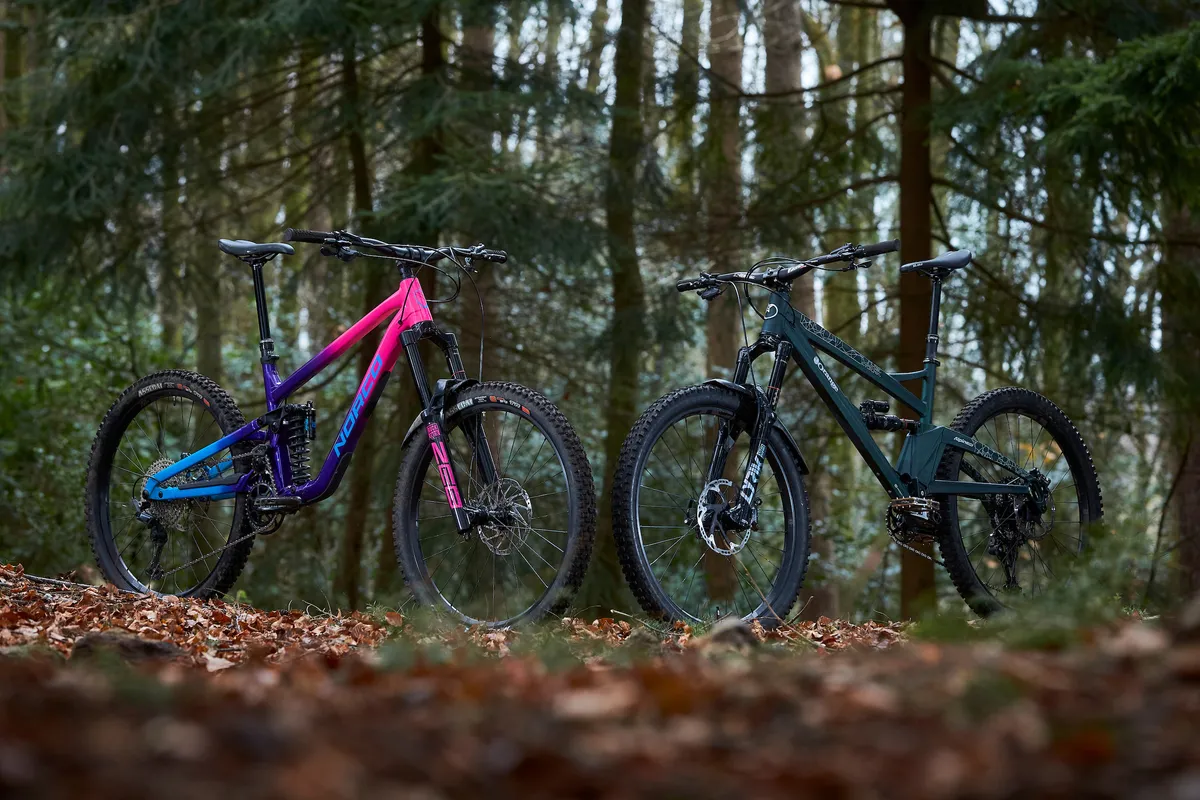
The Jekyll to our Hyde is Norco’s Shore 2. Although the Shore is another remake, this time of an old Norco model, the latest iteration is nothing but forward-thinking in terms of its suspension, geometry and spec.
With a high-pivot placement built around a multi-pivot Horst-link suspension design giving 180mm of rear-wheel travel, it’s at the more extreme end of what you could ride day in, day out.
The Norco is clearly designed for big-mountain riding, but then so is the Orange, especially when you consider its namesake Alpine mountain terrain.
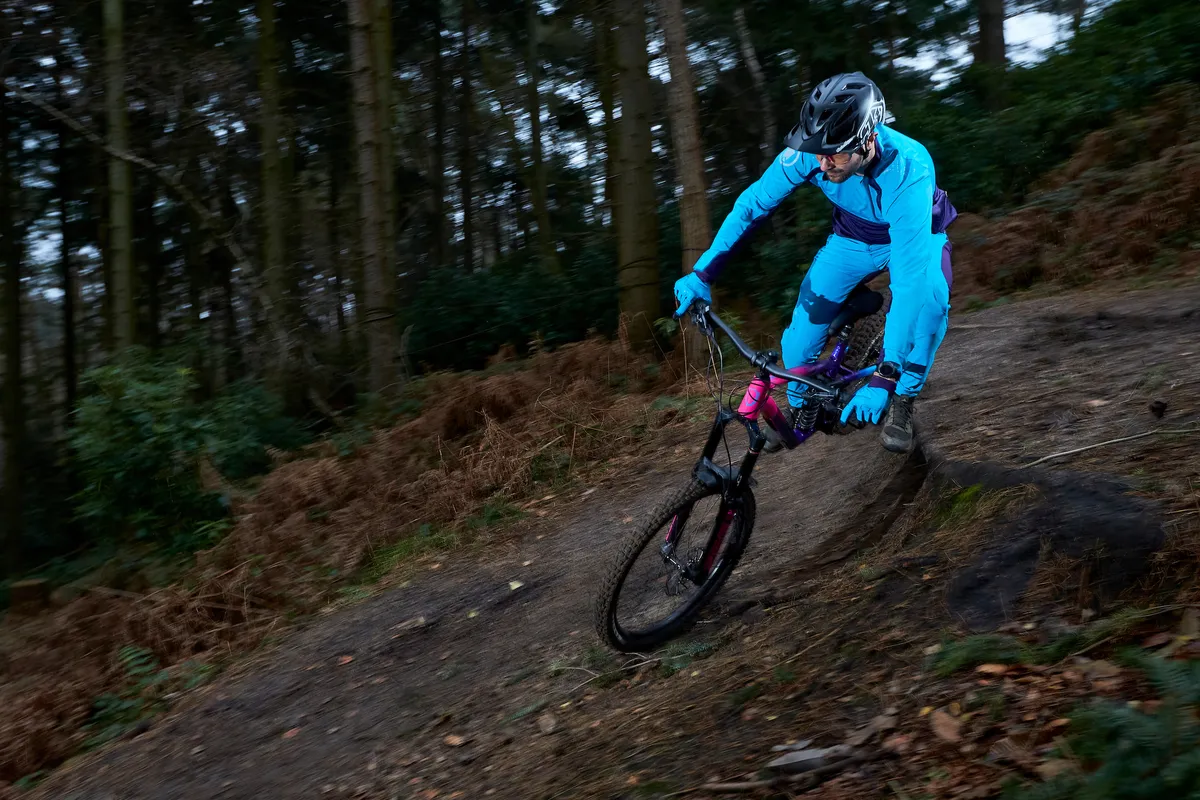
There are plenty of similarities between the two bikes – both run on 650b wheels with Maxxis rubber, are damped by RockShox suspension, and use Shimano’s 12-speed drivetrains and 4-pot brakes.
To truly discover the benefits and disadvantages of both suspension systems, I rode these bikes on the widest range of terrain in the Scottish Borders to find out where they excel and, just as importantly, where they don’t.
Frame, suspension and component specifications
Orange Alpine Evo LE

The Alpine Evo LE (Launch Edition) doesn’t deviate from Orange’s iconic single-pivot suspension, aluminium monocoque frame design. But this model has seen under-the-hood updates, with an increase in suspension progression, and the use of thinner and lighter tubes with a new swingarm, all said to improve its ride.
It’s fitted with top-tier parts, including RockShox’s Ultimate Lyrik and Super Deluxe dampers, plus Shimano’s M8100 XT drivetrain and four-pot brakes. It runs on e.13 TRS rims, wrapped in Maxxis rubber. It’s got a slack 63-degree head angle, steep 76-degree seat tube angle, a long 495mm reach, and generous 445mm chainstays and 1,280mm wheelbase.
- Weight: 14.33kg large without pedals
- Frame: 6061-T6 monocoque aluminium 155mm (6.1in) travel
- Fork: RockShox Lyrik Ultimate 160mm (6.3in) travel
- Shock: RockShox Super Deluxe Ultimate
- Drivetrain: Shimano XT M8100 with Hope Evo crankset (1x12)
- Wheelset: E13 TRS rims on Hope Pro4 hubs, Maxxis Minion DHF 3C MaxxTerra EXO 27.5x2.5in (f), Maxxis Minion DHR II EXO 27.5x2.4in
- Brakes: Shimano XT M8100 203/180mm rotors
- Bar: Renthal Fatbar M35 800mm
- Stem: Hope M35, 35mm
- Seatpost: SDG Tellis 150mm
- Saddle: SDG Strange Bel Air II
- Price: £5,900
Norco Shore 2
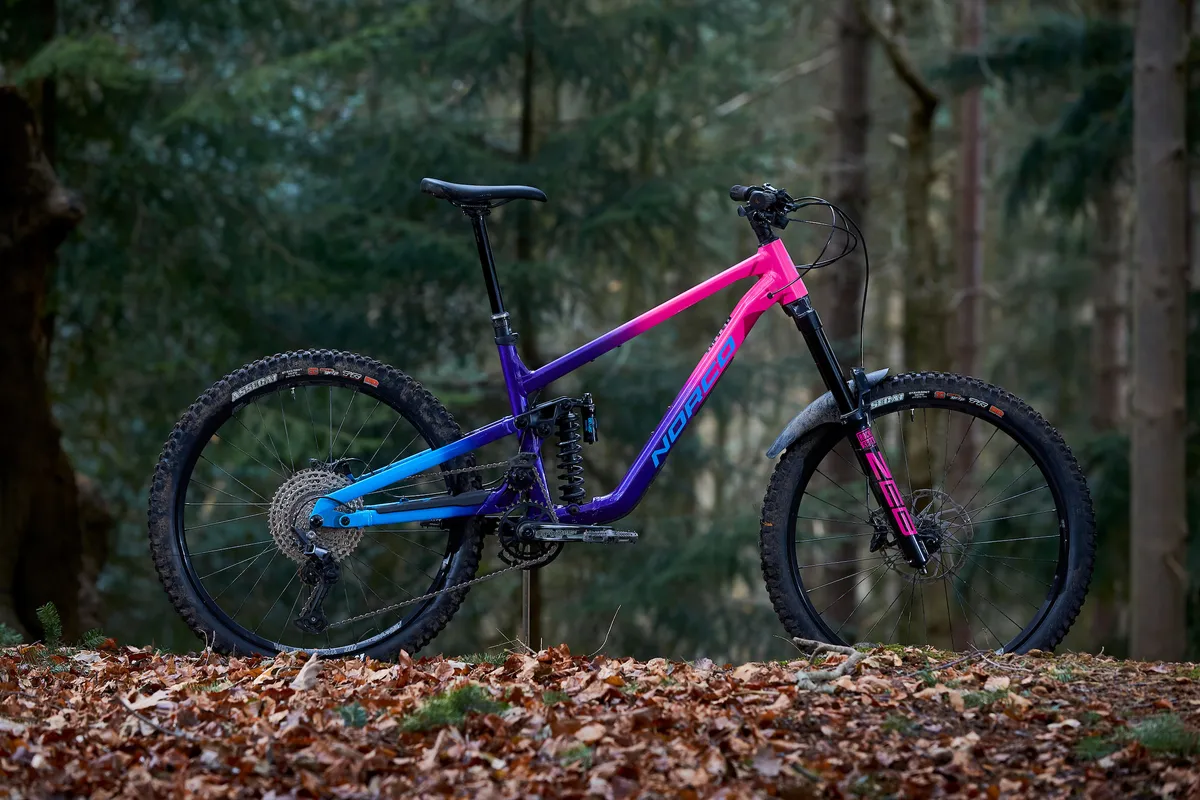
Based around a high-pivot point Horst-link suspension system with 180mm of travel, Norco’s Shore uses an idler wheel to reduce pedal kickback and pedal bob in a bid to make it pedal-friendly.
Its frame is built from aluminium and uses the brand’s Ride Aligned technology, where an online calculator should help you get the perfect setup.
It’s specced with a wide-ranging 12-speed Shimano drivetrain and has a dropper post, along with an impressively steep 77.3-degree seat tube angle that suggests it has better all-day ride capabilities than its travel figure would indicate. Elsewhere, there’s a slack 63-degree head angle and a comfortable 480mm reach.
- Weight: 18.26kg large without pedals
- Frame: Aluminium Freeride 180mm (7in) travel
- Fork: RockShox ZEB R 180mm (7in) travel
- Shock: RockShox Super Deluxe Coil Ultimate DH 500lb/in spring
- Drivetrain: Shimano Deore M6100 with e.Thirteen LG1 crankset and Norco Idler Chain Guide with lower guard (1x12)
- Wheelset: e.Thirteen LG1 DH rims on Shimano Deore hubs, Maxxis Assegai 3C MaxxGrip DoubleDown 27.5x2.5in (f&R)
- Brakes: Shimano BR-MT520 203mm rotors
- Bar: Norco 6061 800mm
- Stem: e.Thirteen Base, 40mm
- Seatpost: TranzX 170mm
- Saddle: WTB Volt 250 Sport
- Price: £3,399 / US$5,199
Which is better, a high-pivot or low-pivot mountain bike?

In the automotive world, an age-long debate rages on about what’s better: an automatic or manual gearbox.
Both have many advantages and disadvantages, but proponents of automatic gearboxes are often heard uttering to traditionalists something along the lines of: “If you own a dog, you don’t want to have to wag its tail,” likening the physical movement required to shift with a manual gear stick to doing the dog’s job for it. Though, arguably in shifting the car’s gears yourself, you’re more engaged with the drive. But is doing so distracting you from focusing on driving fast?
The same thing applies to the two very different bikes I have on test where, in car terms, the Orange is a manual-gearbox, open-top sports car without driver aids such as ABS and traction control, and the Norco is a modern high-speed cruiser with an automatic gearbox and plenty of technology to keep you on the right line, at the right speed.
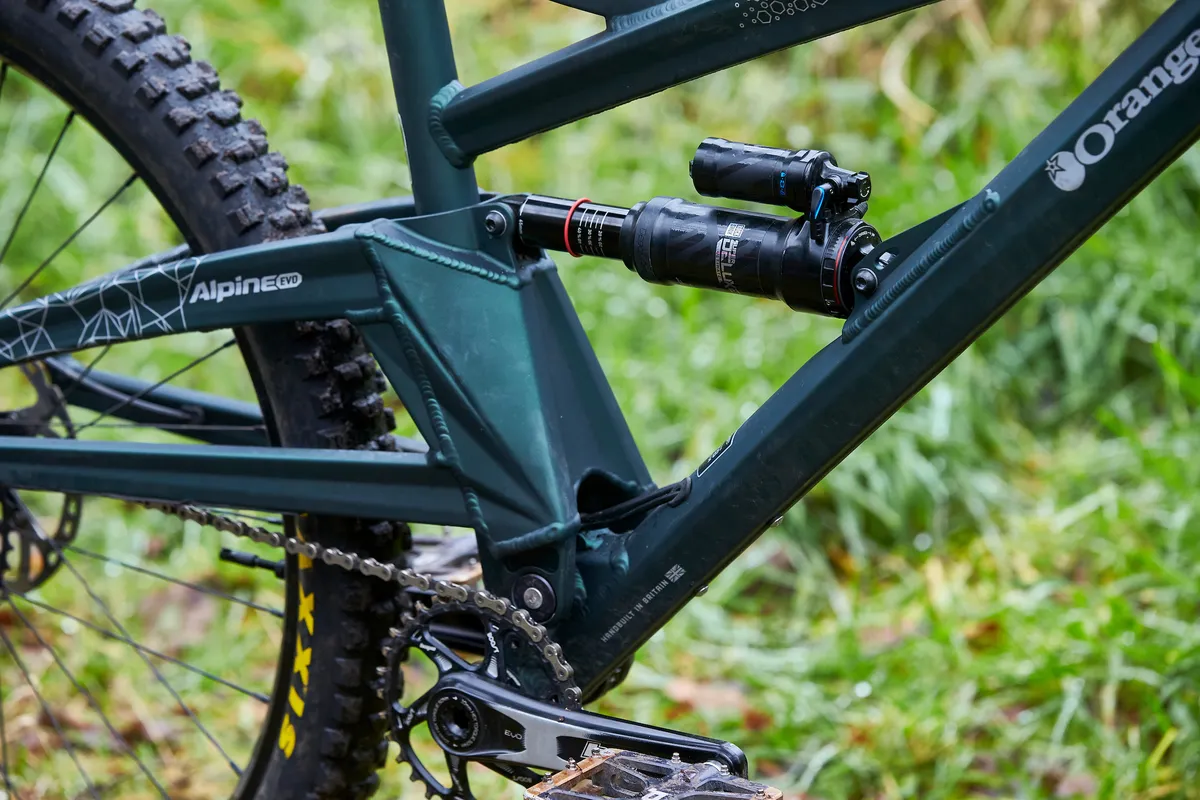
Whether a high- or low-pivot bike will suit your needs, riding style or even terrain type will depend on a lot of factors, and one of the biggest is likely to be your personal preference for how much you want the bike to do for you in any given scenario.
Some of you may already know what you want, but quite a few probably won’t, so we’re going to explain how each of these bikes rides on different types of trail, to help you make up your mind, or reinforce what you already know.
Kinematics kaleidoscope
Orange claims the Alpine Evo is the most progressive Alpine model it has made to date, with a leverage rate that offers around five percent progression (calculated using BikeChecker's linkage application) from uncompressed to bottomed out.
In real terms, this is still quite linear and makes the Alpine Evo’s design best suited to air shocks with adjustable air volumes. Volume reducers can be used to increase the spring force required to compress the shock towards the end of its stroke, and I ended up fitting the maximum number in the Orange’s shock to increase progressivity.
Notably, the Orange’s main, and only, pivot is now just above the bike’s 32t chainring. This should create a neutral pedalling feel with little chain growth, potentially causing the pedals to kick back and minimal bob (anti-squat values over 100 per cent) under power. Its axle path is almost entirely vertical, with a small amount of forward arcing as it enters the last half of its travel.
Technical terminology
- Leverage ratio: The term used to describe the relationship between the distance the rear wheel moves and the distance the shock moves as the suspension cycles. How much the leverage ratio changes as the bike compresses dictates how progressive the suspension will feel
- Air spring volume-reducer spacers: Plastic chips used to tune the volume of the air spring to increase the force required to compress the shock or fork the further into its stroke it compresses
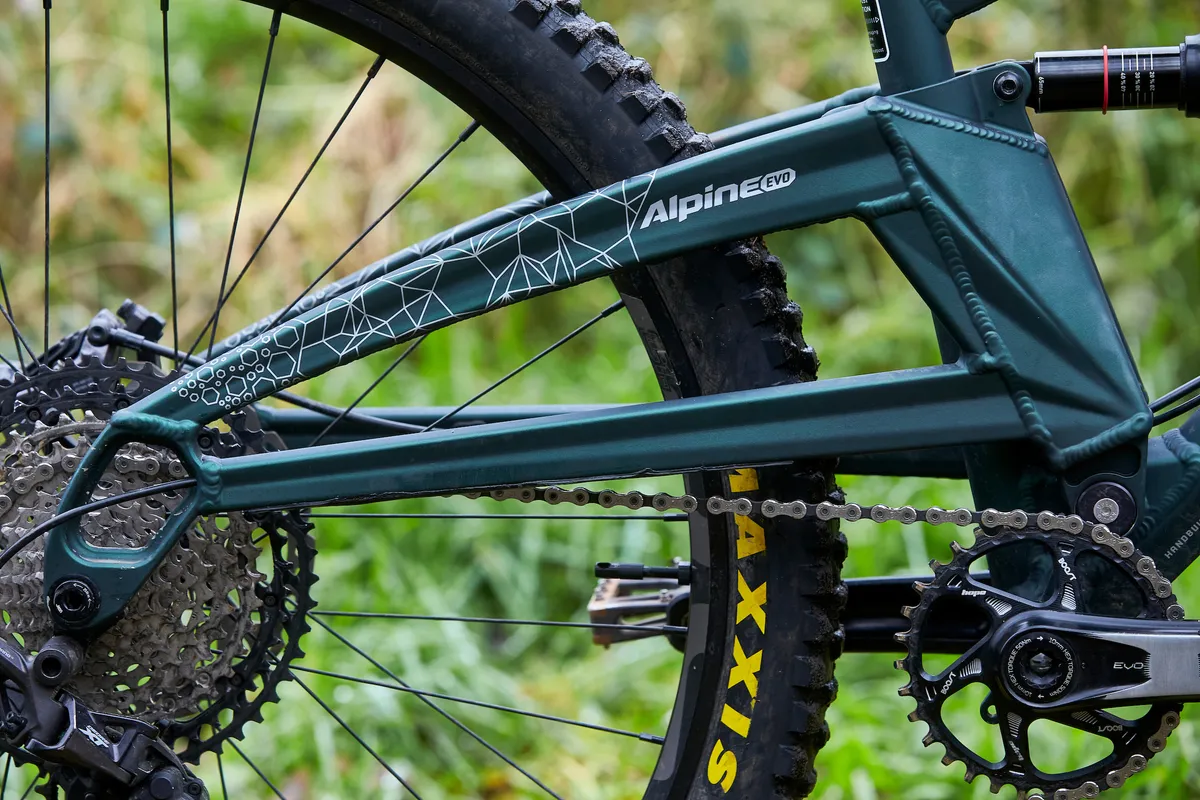
This suspension design is very typical of a low-position, single-pivot system in terms of how it feels on the gas and over rough, chattery terrain. Other brands use various types of linkages to increase the design’s inherent progression, but this in the case of the Orange, is also doable by tuning the air spring.
The Norco, however, comes fitted with a coil shock from the factory. Its suspension is 26.5 percent progressive (also calculated using the linkage application) from fully extended to fully compressed, making it one of the more progressive bikes on the market.

Unlike the Orange, the Norco has a high main-pivot Horst-link design. This high pivot gives its back wheel 13mm of rearward axle movement up to 105mm into its travel, and then the axle starts to travel up and forwards towards bottom-out, finishing -7mm from its starting point at full extension.
Such changes in effective chainstay length can, some argue, make the bike feel strange as it cycles through its rear travel, requiring rider input to mitigate the change. Some people will be more sensitive to these changes than others, making it worth trying out a high-pivot bike on trails you know before committing to a purchase.
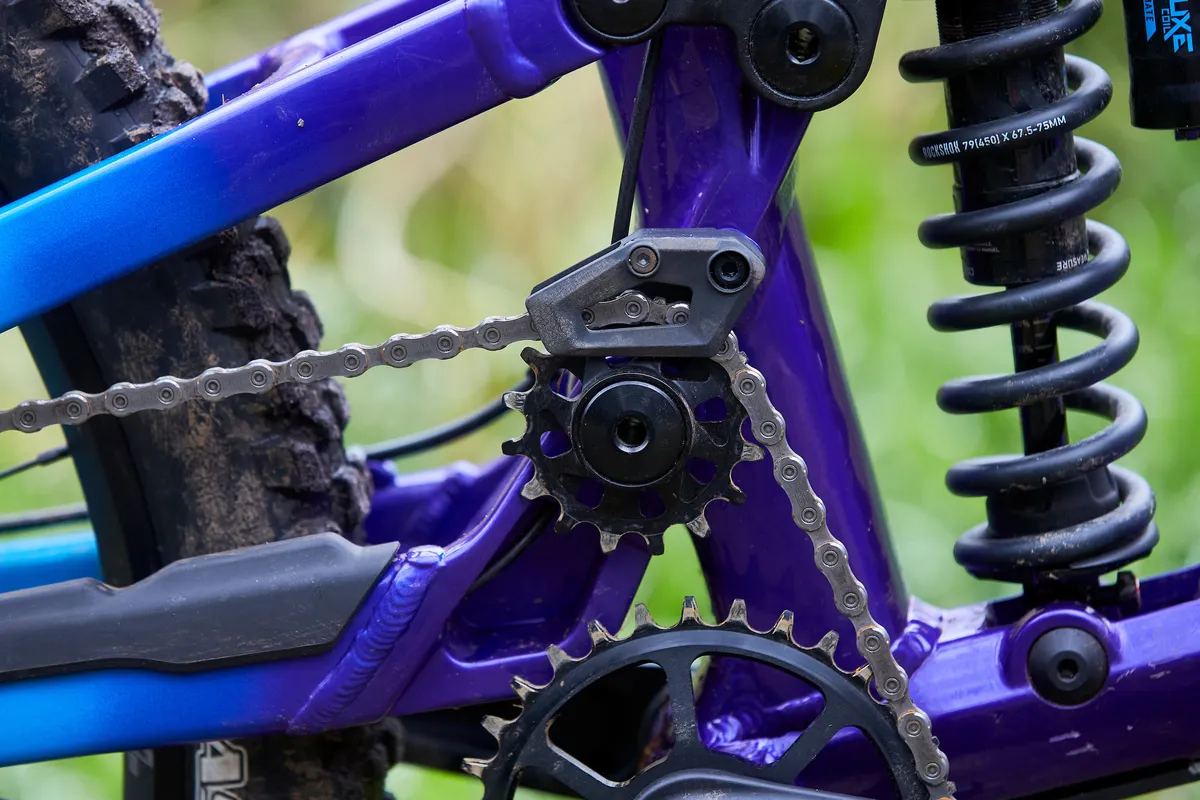
Without an idler wheel to route the chain close to or directly on the main pivot’s location, the Norco would suffer from pedal kickback (as the upper chain line tries to extend), and plenty of pedal bob caused by low anti-squat figures.
To mitigate this, Norco has fitted an idler wheel mounted concentrically to the bike’s main pivot, with the chain running over this idler. This means the Orange and Norco should have similar anti-squat figures, with both bikes’ chains running on or close to the main pivot’s location.
On the gas
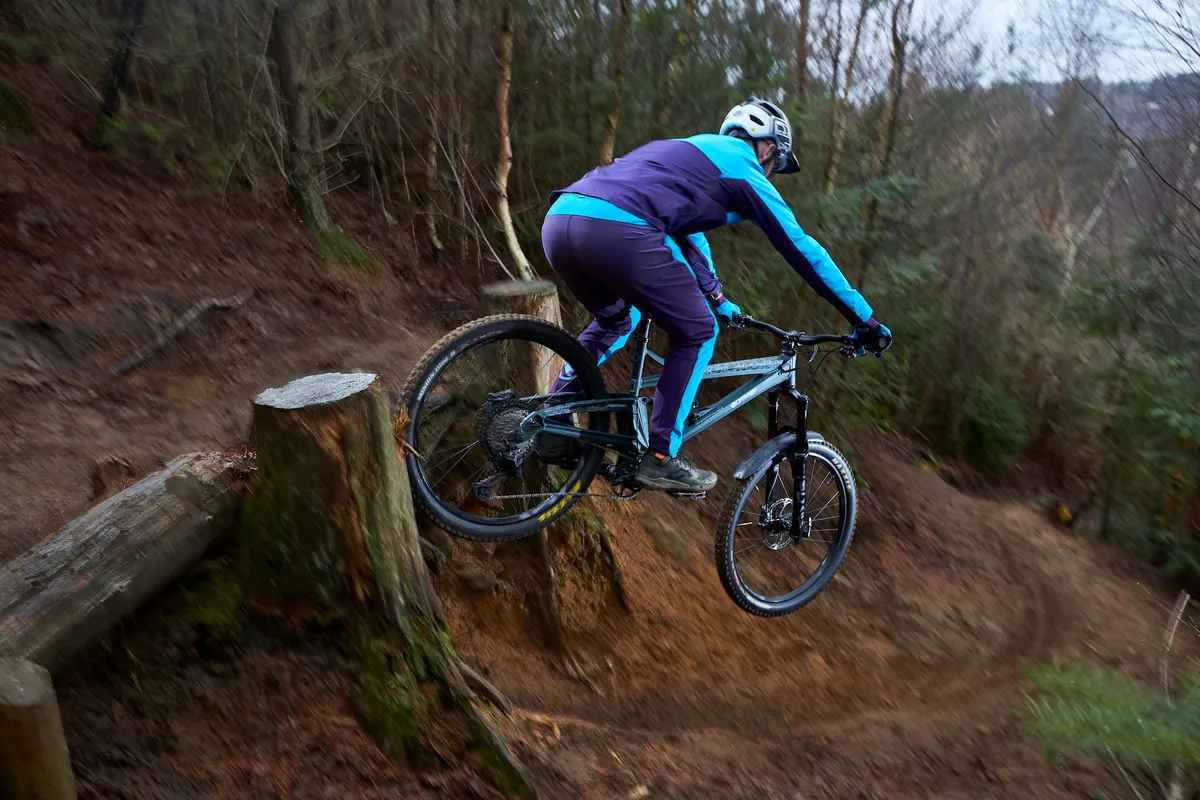
What does all this mean out on the trail? In reality, and true to the theory behind each bike’s suspension system, there’s little to differentiate them on smooth fireroad-style climbs or flat sections. The Orange is not only sprightly on the pedals, where it’s quick to accelerate, but it also does so without any real losses through unwanted suspension movement.
The same is true for the Norco and, given the firepower it brandishes in terms of suspension travel, we were very impressed with how well behaved the suspension was when making progress. In fact, the lack of suspension bob is almost uncanny and feels out of place on a bike with such a luxurious-feeling rear end.
Add a few bumps in to the mix, such as man-made but well-worn trail centres, and suddenly the Norco’s rearward axle path and total drivetrain-to-suspension decoupling – thanks to the idler – pays dividends.
The rear wheel’s ability to track the trail is significant and impressive, providing a traction-rich ride, where scaling almost-impossible climbs becomes a reality as the rear wheel spends its time conforming to bumps and staying in contact with the ground.
Technical terminology
- Anti-squat: How much the suspension resists pedal bob. In theory, bikes with 100 per cent anti-squat neither compress nor extend their suspension systems when a rider pedals. Bikes with more than 100 per cent anti-squat resist suspension compression caused by pedalling forces, while bikes with less than 100 per cent can compress
- Axle path: The trajectory the rear wheel’s axle takes as the suspension compresses. The main pivot placement in relation to the wheel’s axle will dictate the rear wheel’s path through its travel
- Horst-link: The term used to describe a suspension system with a rear pivot below and in front of the rear axle, which means the rear axle is not directly connected to the main frame

It creates supreme levels of comfort, too, because the rider is essentially insulated from any harshness or chatter, and all of this translates to cool, calm and collected pace requiring the absolute minimum of rider inputs.
The Orange, on the other hand, feels rawer to ride. Yes, it accelerates like a scalded cat, but instead of rewarding a passive laissez-faire attitude to bump absorption, it responds well to hops and skips down the trail, interlinked with well-timed pedal strokes to top up any speed lost to harsher or bigger bumps.
The low-pivot design means a rider can’t be complacent towards bumps, and instead must pick and choose where to lift the back wheel and pump backsides. Grip isn’t as abundant, especially when trying to scale slippery, rock-ridden climbs, but the Orange is no less capable, it just requires a totally different approach to the Norco.
Bashing into, or through, a bumpy or technical section of flat or uphill trail isn’t met with the same eagerness to please as the Norco’s high pivot, but work with the Orange and just as much fun can be had if you’re willing to put in the effort.

A frequently asked question about high-pivot bikes is how much pedalling energy are you losing to the idler wheel? Although testing this is possible, it requires specialist equipment to accurately and scientifically work out precisely how much power is lost to drivetrain inefficiencies.
Less scientific testing reveals those losses aren’t more than between one and five per cent. Once the drivetrain has got dirty or is running dry, it’s possible to feel a lumpiness or grittiness through the pedals, but how much of that is an increase in resistance remains to be scientifically answered.
If you like your bike to pedal smoothly regardless of how much mud the drivetrain is covered in, a bike without an idler wheel is currently the only answer.
Pushing the limits
Both bikes’ geometry figures are remarkably similar. They share a 63-degree head tube angle and 445mm chainstays. Wheelbases are similar at 1,280mm (Alpine Evo) and 1,286mm (Shore 2), while reach figures are close too, with the Orange at 495mm length and the Norco 480mm.

Seat tube angles are also comparable. The Orange boasts a 76-degree angle and the Norco a 77.7-degree figure. Arguably, both bikes are at the sharp end of modern geometry and, on paper, should have reasonably similar demeanours out on the trail, were it not for the decidedly different approaches to their rear-suspension systems.
Drop in to smoother, faster trails, even with the gradient on the steep side, and both bikes have an aura of calm about them, where the lengthy reaches, long wheelbases and chainstay figures all combine in a coherent modern package.
Orange Alpine Evo LE details
- Monocoque tubes: Orange has tuned the Alpine Evo’s tubes and made the swingarm asymmetrical to provide a claimed 20 per cent increase in longitudinal stiffness compared to the previous version of the bike
- Pivot placement: By shifting the pivot point down and forward, Orange has tuned the suspension’s kinematics, while retaining the bike’s iconic looks
- British build: The Launch Edition of the Alpine Evo includes parts from other British brands, such as Hope and Renthal
Both bikes are massively well mannered, not easily upset by poor line choice or erroneous weight shifts, their chassis remaining stable and true to where you want them to go.
It’s when the trails get bumpier that the differences start to become noticeable. The Norco does an impressive job of neutralising trail chatter, feeling bewitchingly smooth and composed.
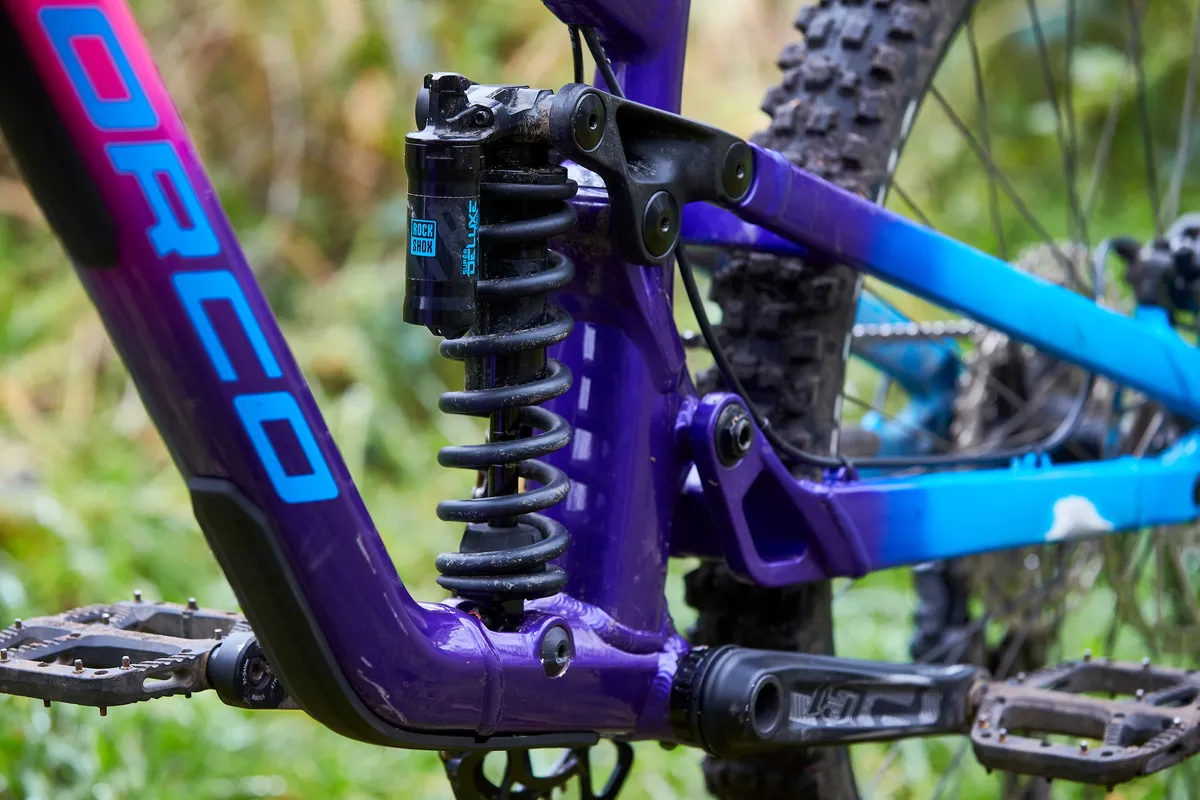
Riding it over repetitive square-edged hits with little to no sympathy reveals just how supple, absorbent and forgiving the rear suspension is, where the bike is doing a massive portion of the work required to keep things on track.
It feels as though its suspension is working overtime to keep the chassis level with the horizon, insulating the rider from having to compensate for instability with energy-sapping weight shifts. This, in turn, creates plenty of extra, easy-to-access speed, because the bike feels keen to accelerate over bumps, rather than its rear wheel getting caught up on them and slowing you down.
The Orange, however, requires a more proactive riding style to keep its speed up and chassis stable. Firing yourself into a mess of roots and rocks can’t be done with a brazen disregard for your wellbeing, but instead needs to be approached with soft, bent arms and legs to ensure control.
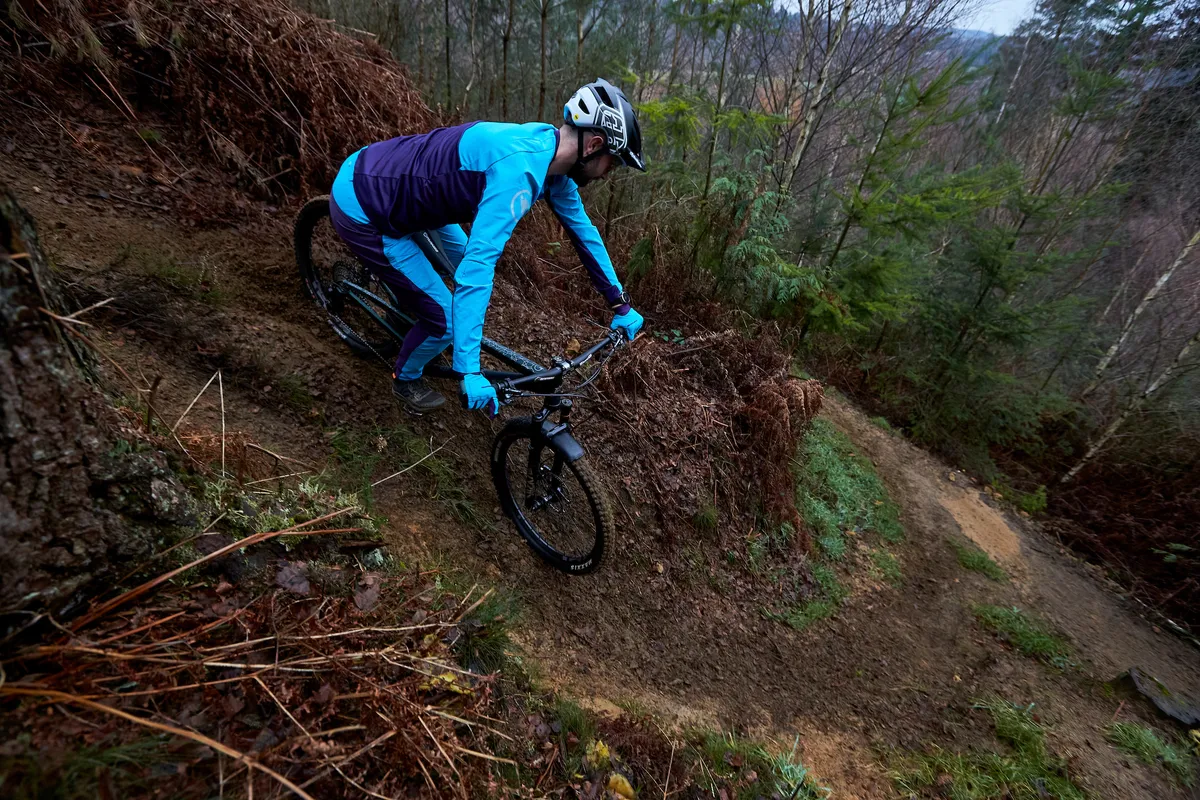
Although the suspension does some of the work of ironing out bumps, quite a bit more of the slack is taken up by your body. When ridden with straighter legs, the low-pivot design tends to crash and bang the rear wheel into bumps much sooner and quite a bit harder than the high-pivot bike.
But if you tackle the same bit of track with lighter wheels, speed can be increased. It’s possible to pick up and pump through chosen sections of trail to generate exhilarating increases in forward momentum without any speed getting lost to the rear wheel with an overzealous willingness to compress.

Get out of jail free card
It’s when you get it wrong that the differences become most stark. Hopping over obstacles on trails can be done on both bikes with ease, but depending on your skill level, accuracy, or the technicality of the trail, the chances of something going wrong can be increased on the Orange.
This is when the high-pivot Norco comes into its own. Tag the back wheel on a root, rock or jump landing, and it does its best to absorb the impact, helping maintain both the bike’s and rider’s composure. This means that a loss of traction or control are a long way down the line of successive, significant errors.
Norco Shore 2 details
- Idler wheel: Mounted concentrically to the main pivot is the Shore’s idler wheel. The wheel has an in-built chain guide to help stop the chain from derailing over rough ground
- Mounting solutions: Norco has included a bottle cage mount on the down tube and a tool accessory mount on the underside of the top tube. These reinforce the Shore’s credentials as an all-day big-mountain bike
- Tacky rubber: Both the front and back tyres feature Maxxis’ super-sticky MaxxGrip rubber and DoubleDown casing tyres. These are perfectly attuned to the Shore’s descent-focused credentials
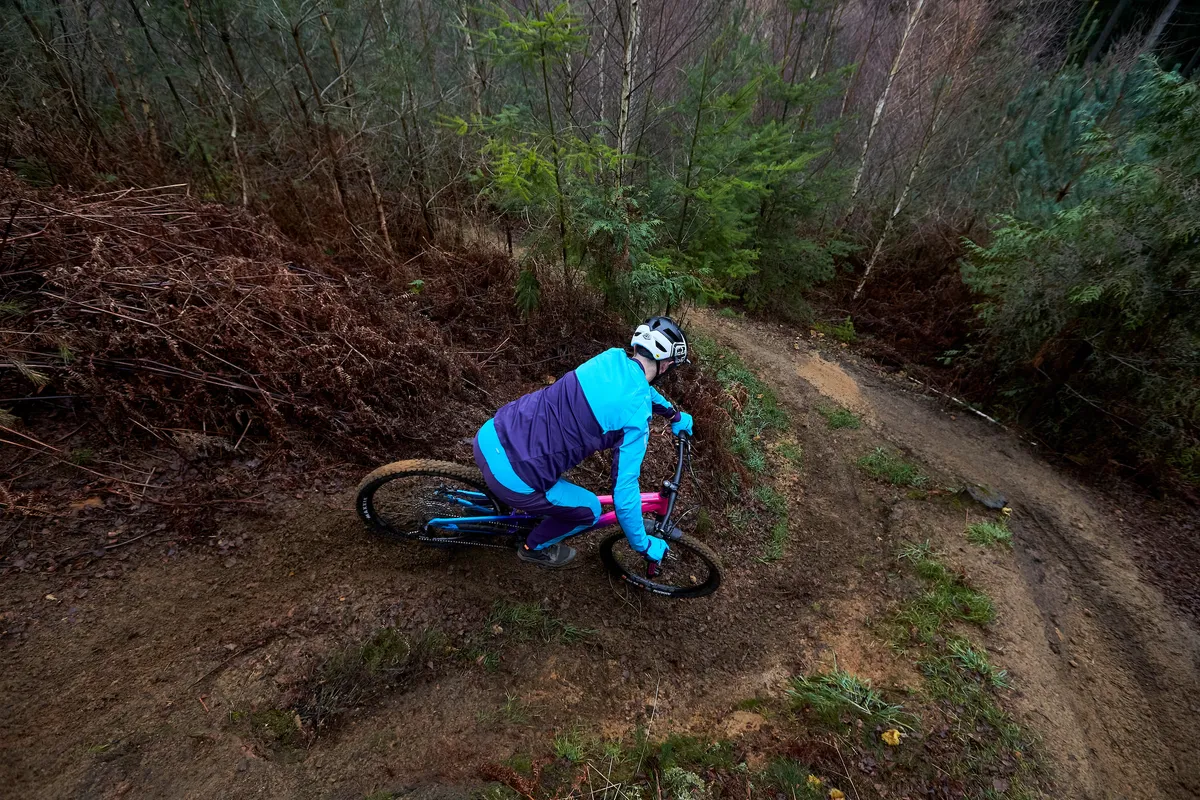
Imagine you're heading down a soft, muddy, steep off-camber section interspersed with large tree roots that need to be jumped to maintain traction, and you tag the back wheel on a root as you come in for touchdown. The Norco’s rear wheel moves rearward and up out of the way, conforming to the bump’s shape and maintaining contact with the ground.
We found that in scenarios like this, if we resisted touching the brakes and locking the back wheel, the high-pivot system did an incredible job of providing the much-needed traction and stability to continue riding the bike as if we hadn’t made any mistakes at all.
Stick the low-pivot Orange in the same scenario and the chances of it all going wrong are higher. Tagging the back wheel on a similar root isn’t met with the same eagerness to compress or the abundantly forgiving traction provided by that high-pivot suspension movement.

The Orange does provide an element of forgiveness, and its back wheel moves up as obstacles are tagged, but not losing control is more heavily weighted to the rider’s skill, confidence and commitment rather than relying on the bike to take over and save your bacon.
In that respect, the margin for error is much broader on the Norco than the Orange, especially on high-speed, ultra-technical trails. One wrong weight shift can end in a hair-raising off-line experience on the low-pivot bike, while on the high-pivot system, there are enough safeguards in place to keep things on track.
Whether or not that’s a problem for you depends on your preferences. High-pivot bikes are suited to outright speed and won’t punish a lack of finesse. While low-pivot bikes aren’t any less slow, they require a higher attention to detail to eke out the last little bit of pace on gnarly trails. That can feel exhilarating, though, and is something the Alpine Evo rewards wonderfully.
Going deep

Get both bikes towards bottom-out, say through a compression or in a berm littered with square-edged hits, and there’s little to distinguish them from one another. Both their rear-wheel axle paths start to arc forwards as they get towards the end of their travel, which means the rear wheel is compressing towards, and into, bumps rather than vertically up or rearward out of the way.
This leads to some harshness transmitted through the wheels into the frame and can result in dinged rims or punctured tyres. Both the Norco and Orange were guilty of this, especially in high-loading stations. If you’re riding hard like this, we recommend looking into running thicker-casing rear tyres to help protect your rims and reduce the chances of punctures.
The same is also true for absorbing jumps or drops to flat. There was little to differentiate the two suspension systems in terms of how well or smoothly they handled the impacts. The biggest factor dictating landing smoothness is how progressive the suspension is, and how much travel a bike has, rather than whether its pivot is high or low.

Should you buy a high-pivot or low-pivot mountain bike?
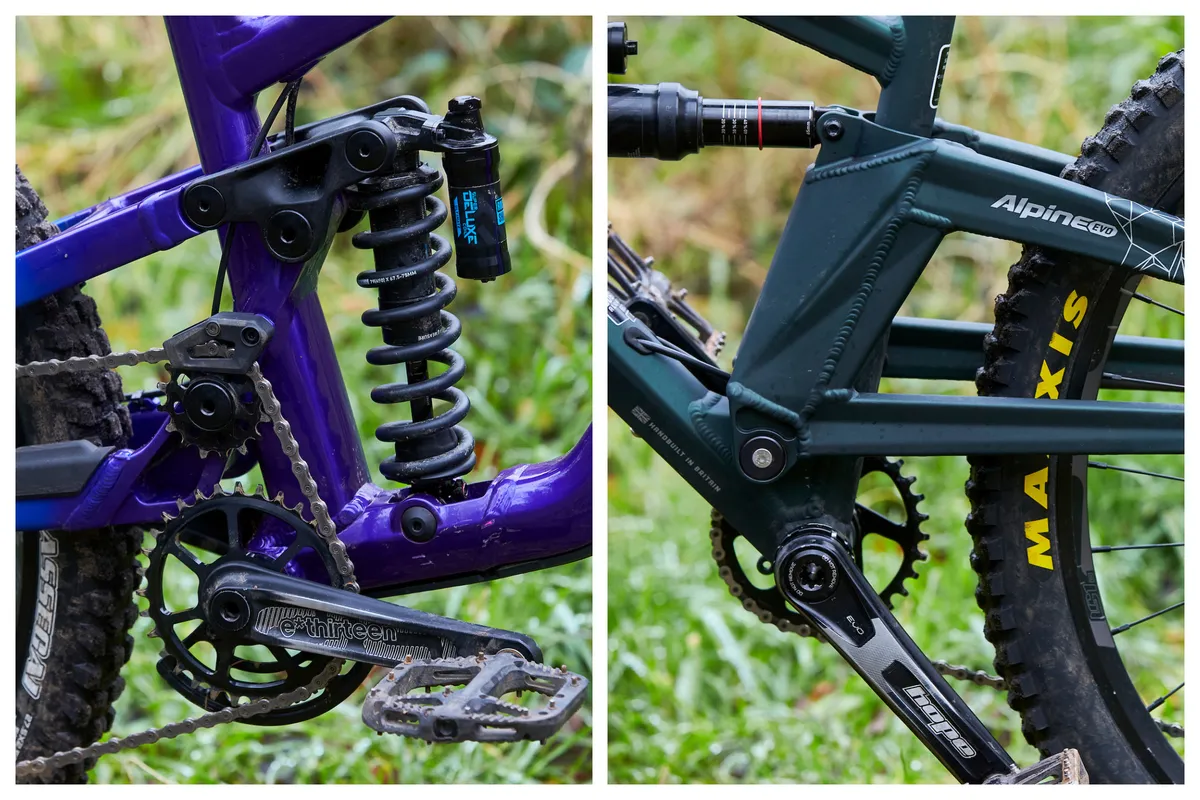
Riding these bikes back-to-back was a surprisingly educational experience. While the differences were stark in places, they were less obvious than you might expect in an equal number of other riding scenarios.
The chunky, high-pivot Norco is certainly smoother over trail chatter, whether ascending, on the flat or descending, and you don’t really notice its hefty weight. Grip is more abundant, too. It’s still exhilarating to ride fast, though, and it reaches high speeds more easily than the Orange.
At that point, how much help the more rearward axle path provides is maybe down to personal perception – the high-pivot, Horst-link design isn’t a ‘silver bullet’ solution to every trail obstacle, technique weakness or terrain type you’re likely to come across.
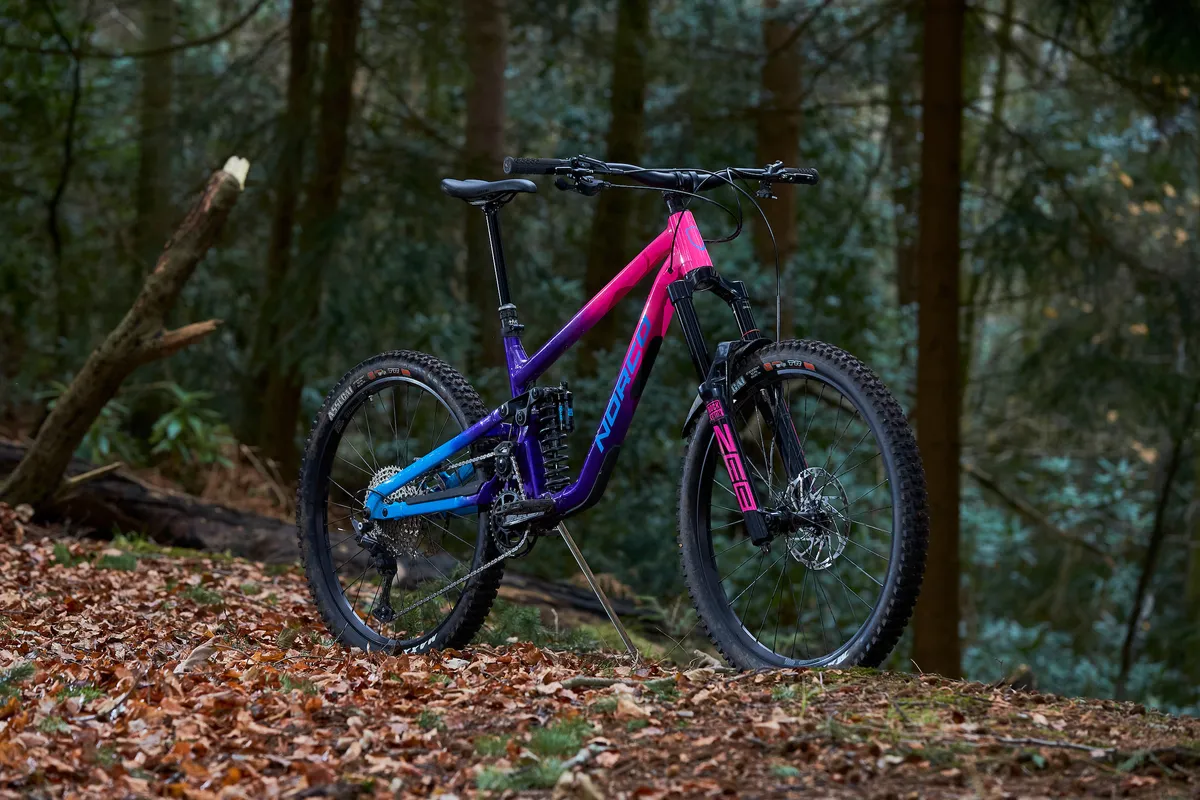
The Shore 2 is one of the best bikes we've tested in recent times.There’s still plenty of life left in low-pivot bikes, as the raw, hyper-connected ride feel of the Alpine LE proves.
The rewards of nailing a section to perfection, earning the associated speed increase and knowing that’s down to the rider, not the machine, makes them an appealing prospect. The connection between rider, bike and trail isn’t dumbed down, and the work required to get from A to B is mostly your own. That’s massively gratifying.
To come back to our original analogy, riding a high-pivot, multi-link bike is like driving a capable modern car with an automatic gearbox, traction control, ABS or a ‘drift mode’, at its limits.
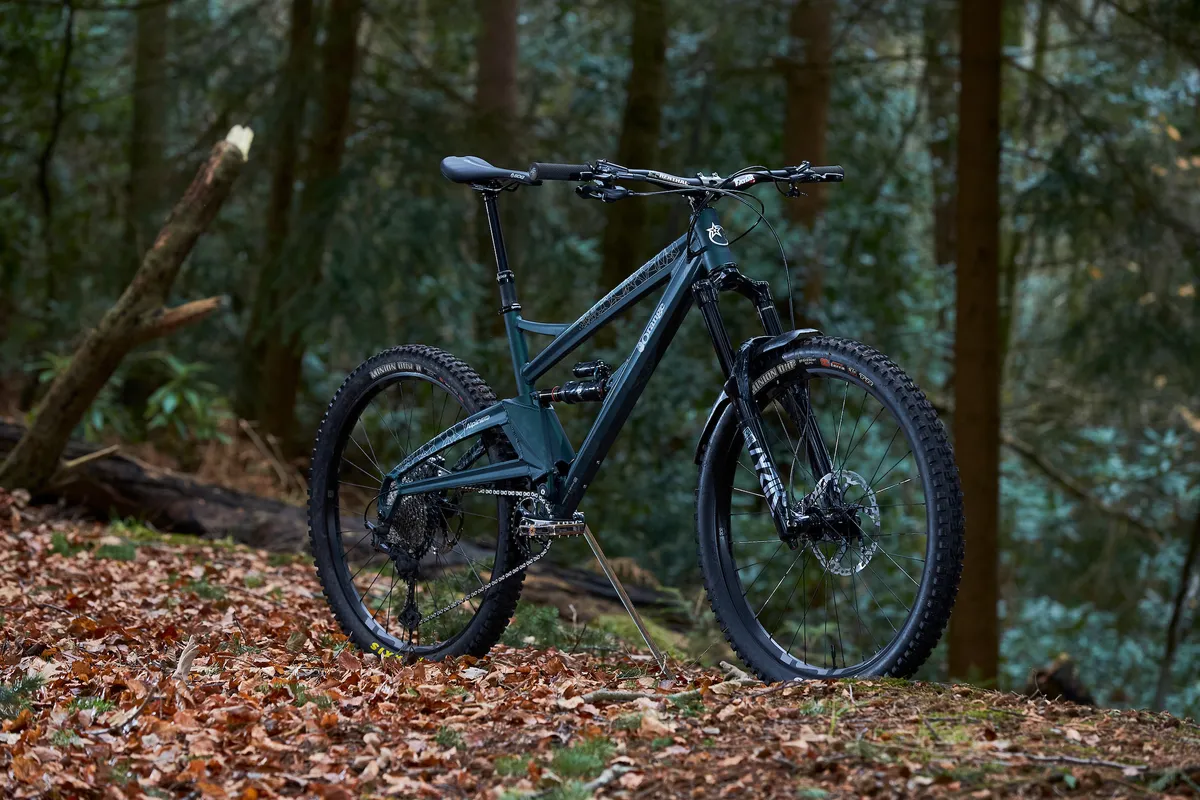
The Alpine Evo LE is the Launch Edition of the brand's newest Alpine model. Accessing higher speeds requires less finesse than on a low-pivot bike – and especially one with a single pivot, like the Orange – because the rear suspension is augmenting rider skill and making up for errors, in the same way that those neat technological advances do in a car.
A bike with a low single-pivot on the other hand, is more like a stripped-back, open-top classic sports car, where putting a wheel wrong increases the potential for disaster exponentially. But the visceral connection with the machine is still appealing, and makes deciding between these two types of design tricky.
Then, of course, there are bikes that sit somewhere between these extremes, with lower main pivots but a linkage to control the axle path, and some of the traits of both designs. Each will suit a certain type of rider. Unfortunately, that means the question of ‘which system is better?’ is truly unanswerable.

Orange Alpine Evo LE bottom line
The Orange’s bang up-to-date geometry and super-responsive chassis make it hugely fun to ride on all types of terrain. Its suspension doesn’t dumb down the trail, and rider skill and commitment are the best way to get the most from its low-pivot suspension design.
Norco Shore 2 bottom line
This high-speed masterpiece rewards brave line choices with a dependable, passive neutrality. Get things wrong and you can count on the high-pivot Shore being there to help you out. It lacks some engagement and feedback, but more than makes up for it with its sheer pace.

